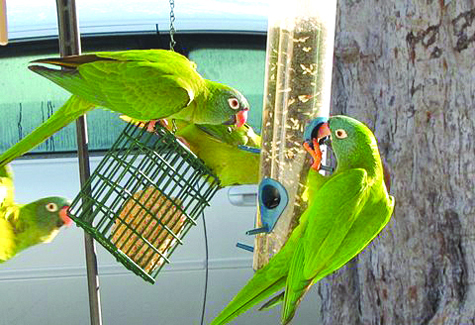Focus on Nature: Parakeets win for color and noisiness
 Monday, February 21, 2011 at 10:00
Monday, February 21, 2011 at 10:00  BARBARA STOUTENBURGH PHOTO | A noisy group of blue-crowned parakeets squabbles at the feeder.
BARBARA STOUTENBURGH PHOTO | A noisy group of blue-crowned parakeets squabbles at the feeder.
As our lives have slowed down, Barbara and I have been spending our winter months down in Florida, where we follow our feathered friends by looking for them as we travel around on the shores or inland, but mostly by enjoying them daily as they visit our feeders.
Up North during the cold winter months when food becomes scarce feeders become more important and you are able to attract the regulars like the chickadees, nuthatches, titmice, downy woodpeckers, red-bellied woodpeckers and house finches.
You might also see some of the more unusual birds at your feeder during the extremely cold weather, such as the fox sparrow, the white-throated sparrow, the Carolina wren or the flicker.
The one bird that you have at your feeders that we see down here in Florida is the red-bellied woodpecker. They are at our feeder regularly with the grackles and English sparrows. Both the male and female red-bellied woodpeckers are around every day. If there doesn’t happen to be any food out when they arrive, we hear them scolding us even before we are up.
They enjoy sunflower seeds, and if there are any peanuts mixed in they’ll pick them out first. Just across from us there is a huge old Australian pine tree where the red-bellies stash their sunflower seeds into cracks and crevices for later use. They also use the telephone poles nearby where there are many holes from the servicemen who have used climbing spikes or gaffs to climb up the poles
The main food for all woodpeckers is insects and grubs that burrow beneath the bark of the tree. Their stiff tail feathers act as support as they work their way up and down the tree. This red-bellied woodpecker has the added advantage of being able to stick out its barbed tongue nearly two to three inches beyond the end of its beak to search under the bark. The tongue is sticky, making it easy to pull out prey from deep crevices.
While we enjoy watching the red-bellied woodpeckers at our window feeder, our real treat down here in Florida is the daily visits of the colorful and noisy parakeets. We have three different species that visit us: the monk, the blue-crowned and the black-hooded.
Parakeets originate in South America, where they are a major agricultural pest. The most common of the three are the monk parakeets, with their bright green upper parts, pale gray forehead and breast, and an orange hooked bill. The monk parakeet is most common as it can withstand the cold of the northern climate. There are colonies up around our area in New York, New Jersey, Connecticut and Rhode Island.
Kept as pets these noisy birds can acquire a large vocabulary. We recently spoke to someone who saved a young monk parakeet that had fallen out of its nest. They raised it to adulthood, when it became quite a pet and a friend to the family dog.
The monk parakeet is the only one that builds a large stick nest in trees or man-made structures, where many pairs live together rather than having a single hole or crevice in a tree. We’ve seen these nests in many places where we have traveled, and right here around the block from us there was a big nest with many noisy families living together at the top of a telephone pole.
The parakeet that comes to our feeder in the greatest numbers is the blue-crowned parakeet. This is one of the largest parakeets. Its nest is just a hole in a tree. It has green plumage, a long tapered tail, black and tan colored beak and has a most noticeable featherless eye ring. The dull blue covering covers the forehead, crown and cheeks. The tail feathers are green on top, maroon to reddish brown underneath, changing to a bright orange and scarlet as they fly. As the morning or late afternoon light hits the colorful feathers of these birds at the feeder they are an unforgettable sight.
Of the three parakeets that visit us, the one that shies away from our feeder but sits and screams on the wires above and in the treetops is the black-hooded parakeet — as we write this there are two screaming outside as they look simply striking feeding high in the tree near us in the late sun of the day. Caged birds have been released in numerous places, and in nearby St. Petersburg they have been well established.
It is hard to describe the coloring on this bird. As it sits in the sun feeding with others of its kind, we can see the black facial mask and beak. It has black trailing flight feathers on its wings and a long tail edged in blue. The upper chest is bluish green and the lower chest has paler green feathers, while on the thighs there are very noticeable red feathers (almost circus-like in color).
It is said they are known for their very loud call, as we have noticed. In fact some, and we, would say they “scream.” You can always tell when they are in the area.
While we have some of the birds that you have during the winter on the North Fork, the birds that catch our attention most down here are the noisy and colorful parakeets.


